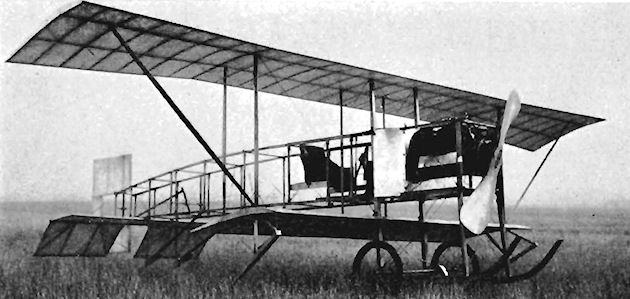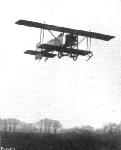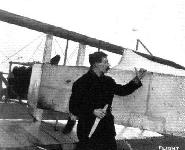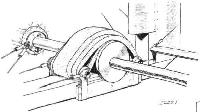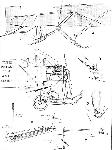P.Lewis British Aircraft 1809-1914 (Putnam)
Jezzi 1911 Biplane
Leo Jezzi's second biplane appeared during 1911 and was built at his home in Bromley, Kent. It was a two-seater powered by the eight-cylinder 35 h.p. J.A.P. engine used originally in the Jezzi Pusher Biplane of 1909.
Spruce was employed throughout for the airframe, all of which was very square-cut and angular in appearance and yet of pleasing proportions. The pair of deep-chord, streamlined centre-section struts extended from the upper wings, through the fuselage and the lower wings and downward to carry the undercarriage. English ash was used for the skids, and all struts were faired and of streamlined section to reduce head-resistance. Warping was employed on the wings whose upper planes had a span of 27 ft. 7 ins., while the lower set were 14 ft. from tip to tip. The considerable overhang above was supported by compression struts, but these were removed and their work undertaken by kingposts and wires. Auxiliary skids were fitted midway on the underside of the wings and twin skids supported the tail on the ground. It was then decided that the lower wings should be increased in span to match the upper pair, thereby converting them into two-bay cellules, and the kingposts were removed at the same time.
When it was ready, the machine was taken to Jezzi's shed at Eastchurch on the Isle of Sheppey and assembled there in 1912. It proved to be a very successful flyer with a brisk performance on its 35 h.p. and was able to carry a heavy passenger in addition to the pilot.
SPECIFICATION
Description: Two-seat tractor biplane. Wooden structure, fabric covered.
Manufacturer: P. G. L. Jezzi, Bromley, Kent.
Power Plant: 35 h.p. J.A.P.
Dimensions: Span, 27 ft. 7 ins. Length, 24 ft. 6 ins. Wing area, 220 sq. ft.
Performance: Maximum speed, 65 m.p.h.
Показать полностью
M.Goodall, A.Tagg British Aircraft before the Great War (Schiffer)
Deleted by request of (c)Schiffer Publishing
JEZZI No.2 biplane
Jezzi discarded his first biplane, replacing it with No.2, which appeared in September 1911 at Eastchurch, where he ran it at high speed on the ground to test features of the machine, which was still incomplete and uncovered. On 13 January 1912, it was reported that he used the machine to tow the Brocklehurst monoplane back to the hangar, after it was stranded on the airfield. The machine had been covered by the end of November.
The first flight of No.2 is not recorded, but by 10 March 1912 he had already flown and carried several passengers. The machine had been modified by August 1912, by the addition of extensions to the lower wings, making the wings of equal span. In this form Jezzi used the machine continuously at weekends throughout 1912. As an amateur designer and constructor with limited time and resources, Jezzi made a machine which was fast, very reliable and served him well.
The design was of a simple tractor two-seater, with tapering wooden fuselage girder, mounted on struts between the wings. The top wing had considerable overhang when the machine was originally built as a single bay biplane, with strut and kingpost bracing of the overhanging portion, which was flexible for warping of the inversely tapered trailing edges. The struts and kingposts were removed when the machine was converted to a two bay biplane.
A streamlined headrest was provided behind the pilot, and streamlined fairings were added to the supporting struts for the fuselage and undercarriage. In addition to twin skids on the main two wheel undercarriage, the axle of which was sprung by rubber bands, twin tail skids and skids, below the first interplane struts, were provided, all of which were laminated springs. There was a balanced rudder, but no fin, and a tailplane with divided elevators, all of which were parallel and square ended.
Power: 35hp JAP eight-cylinder, air-cooled vee, driving a 7ft 8in diameter tractor propeller
Data
Span top 28ft After conversion 27ft 7in
Span bottom 14ft After conversion 27ft 7in
Chord. 4ft
Gap 5ft
Length 24ft 6in
Area 166 sq ft After conversion 220 sq ft
Area tailplane 10 sq ft
Area elevators 15 sq ft
Area rudder 9 sq ft
Speed 65 mph
Показать полностью
Журнал Flight
Flight, December 14, 1912.
A VISIT TO THE JEZZI CAMP AT EASTCHURCH.
IT was horribly cold and wet and, taking it all round, an unusually miserable prospect when I rolled out of my bed at half-past seven in the morning. Even getting that far was something of an accomplishment, I thought. There did not seem much use in going down to Eastchurch that day. Eastchurch, with its perfectly wonderful train service, is quite a sufficient handful on a fine, warm day. But it was no use meditating on things in general, for an appointment is an appointment whatever the weather may be like. And so it was that three shivering mortals - I had been, meantime, joined by two of my colleagues - turned out of the lethargic little train that occasionally runs from one end of Sheppey Island to the other, and made their way as cheerfully as the weather conditions would permit towards the flying ground.
Everything was shut down and not a soul was in sight, as might have been expected. A buzz from Messrs. Short, Bros.' works, however, told that there was plenty going on inside.
We found Mr. Jezzi quite alone in overalls, with a scarf round his neck and carpet slippers on his feet, busy in his shed. He was hard at it, fitting wind deflectors between the two V-set rows of cylinders of his J.A.P. engine so that it would keep cooler when running. And perhaps the old motor deserves it, for it has seen Mr. Jezzi through a hard two years of experimenting. It was formerly fitted to Mr. Jezzi's first machine, a biplane somewhat similar to a Wright machine, but driven by two tractors in front, which were supplemented to some extent in their efforts by a third, a miniature one in front of the motor, whose main duty was to keep the engine cool.
The machine did a lot of flying in its time before it was scrapped to give place to the interesting little machine that Mr. Jezzi has been experimenting with for the past nine months. On it, the old machine, Mr. Jezzi passed the tests for his pilot's certificate, and his friend, Mr. Arthur Cooper, who has cycled down to Eastchurch most week ends, lending invaluable help during the whole time Mr. Jezzi has been there, would have done so, too, for he used to handle the machine extremely well in the air, had it not been for a series of minor mishaps.
The present machine is a most attractive-looking miniature biplane. It was built in its entirety by Mr. Jezzi himself in a workshop adjoining his private house, south of London. That he should have been able to complete it at all is rather a wonder, for a city man has not, as a rule, much time to devote to a hobby. But notwithstanding strenuous days in the city, Mr. Jezzi has put in equally strenuous evenings, and more often nights, in his workshop following out his fascination for aviation. Week-ends and business holidays are the only periods when he can get away to his shed at Eastchurch. I recall that I felt rather a hero rolling out of my bed at 7.30 a.m. This impression collapsed somewhat when it came out in the course of conversation that Mr. Jezzi had turned out, in pitch darkness, before six that day, and had come down all the way by road on his 2 3/4-h.p. Douglas - and on such a morning!
But it is not often that business will allow him to get down to Eastchurch so early. It is usually after lunch time that he arrives at his shed. About 10 feet of one side of his hangar is partitioned off into a living and two sleeping rooms, and these are invariably inhabited by Mr. Jezzi and his friends from Saturday midday till Sunday night; then it is a case of getting back to town in readiness for business next day. Thus work proceeds and has proceeded for the past two years.
And the outcome? Amongst many things, a tremendous fund of constructional and flying experience, a constitution hardened and made perfectly lit as the result of the open-air life that practical experimenting such as this offers - and an extremely promising biplane. And so we gather round the machine, admiring its many neat points. Meanwhile, Mr. Jezzi returns to his work on the motor. At last the wind deflectors are fitted, and he proceeds to test the engine. Shutters at the end of the shed behind the machine are taken down - otherwise they might be blown down by the propeller slip-stream as soon as the engine is started. A Navy man pulls over the propeller and the motor roars into its note. The place gets full of blue smoke, and with the draught we all get well nigh frozen.
It was with some amount of satisfaction, therefore, that we heard the cry of "Tea's ready!" coming from the little living room.
Inside there was a small stove packed to its uttermost capacity with white hot coke. The effect on our spirits was remarkable. The blinds were drawn across the windows, and the four oil lamps were made to shed a comfortable light on the scene.
There were two sheets of newspaper on the table for a tablecloth, and on it were arranged enamel cups, and knives and teaspoons enough for a party of five, for Mr. Arthur Cooper had by then arrived, bringing with him his contribution towards the "stores" - two big loaves of bread and a pound of butter. In addition, Mr. Jezzi had produced from his larder - a propeller box nailed to the wall - liberal supplies of lovely preserved ginger and jam.
Let us draw the curtain over the picture of a party, exhibiting enormous appetites, rapidly becoming cheery under the comforting influence of honest bread, butter and jam and steaming tea, for it is all in a day's march when you are learning the gentle art of aviation.
The Machine.
The present Jezzi biplane is a machine that has been designed to fly at a high speed with comparatively little power. The biplane's normal speed with the motor pulling moderately well is about 65 m.p.h., which is no mean achievement with an engine power of 35-h.p., especially as the machine's capabilities do not alone lie along the line of speed. It is a common occurrence for Mr. Jezzi to take a passenger of 12 stone for a trip round the ground, while on one occasion he actually flew with a 16 stone passenger, although on this occasion the heavy load did make the machine drag its tail somewhat.
To obtain this efficiency Mr. Jezzi has endeavoured to cut away as much head resistance as is possible. There we find that there is only one rank of struts - carefully stream-lined ones at that - between the planes, and that there are few cross bracing cables. The body of the machine, too, is covered in throughout its whole length with fabric, and is sufficiently wide against the tail to allow of the levers operating the rudder and elevators to be disposed inside.
The planes were, until quite recently, of 28 ft. and 14 ft., span respectively for the upper and lower spreads. Just lately, however, extensions have been fitted to the lower plane to bring it to the same span as the upper surface. Their maximum camber is relatively small, just 1 1/2 ins., their maximum thickness 2 ins., and their incidence to the relative wind in flight from 4 to 5.
In the construction of the machine ordinary but particularly clean spruce has been made use of almost exclusively. Indeed, the only other wood that is used, and the only section of the machine in which it appears, is English ash for the landing skids. For the landing gear our sketches show its chief characteristics, and little need be said, except that it is very solidly built and has given no trouble whatsoever, although it has had to take landings in some of the roughest parts of the Eastchurch ground. The control of the biplane is, perhaps, the simplest system that is in use at the present day. It had a vertical lever, universally jointed, which controls the elevators and the wing warping, and a pivoted foot bar that operates the rudder.
Показать полностью
